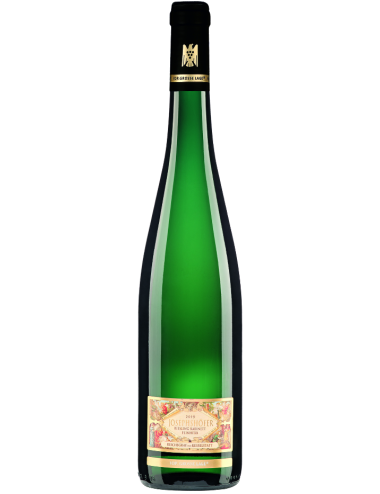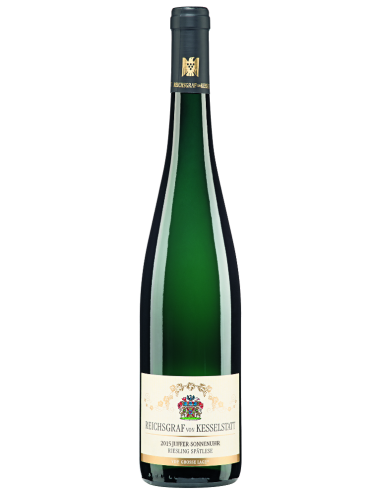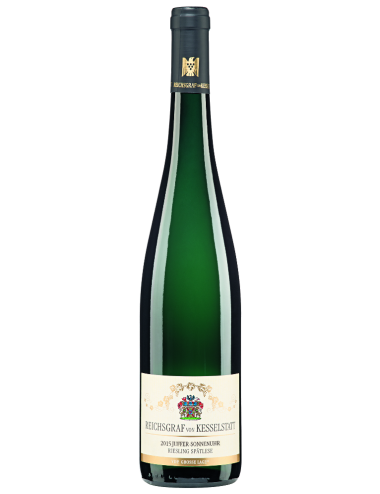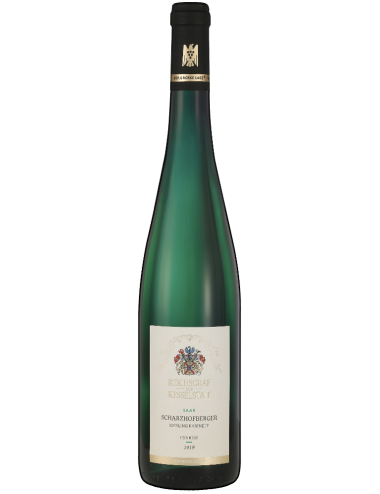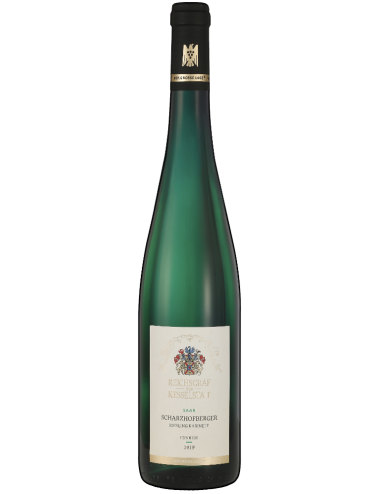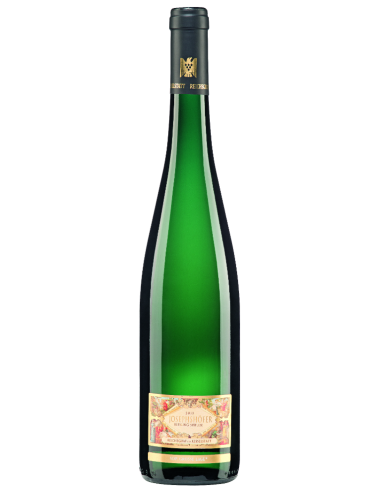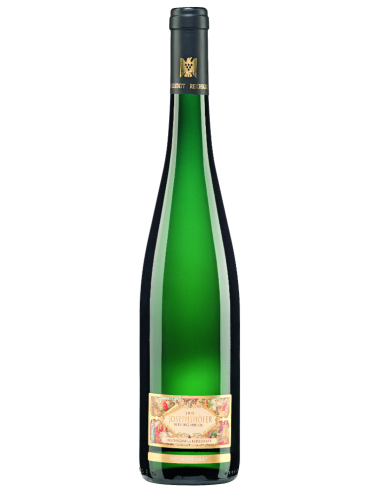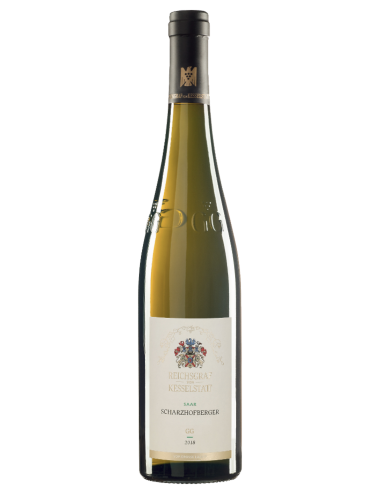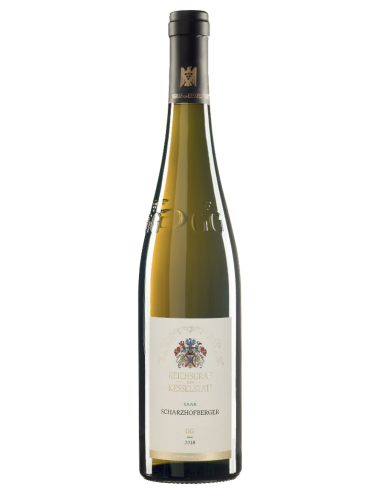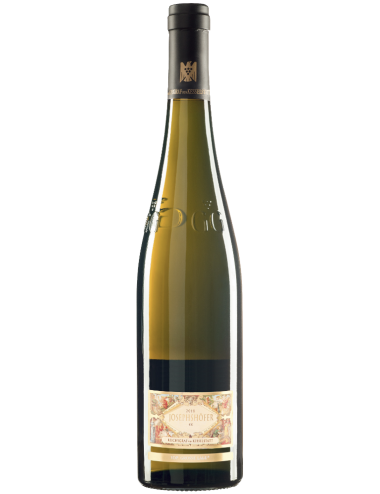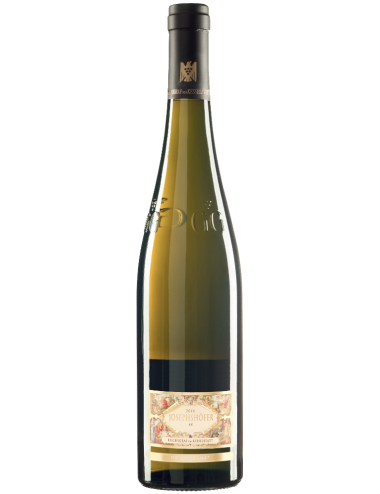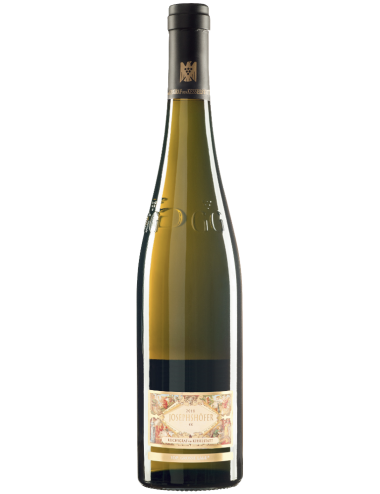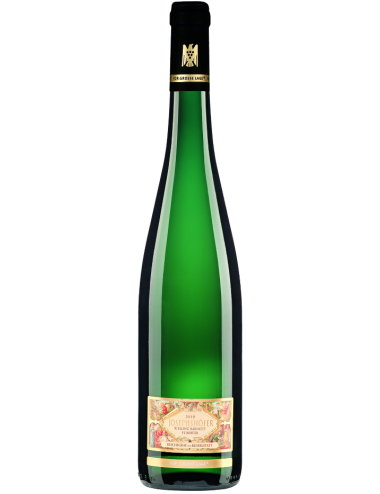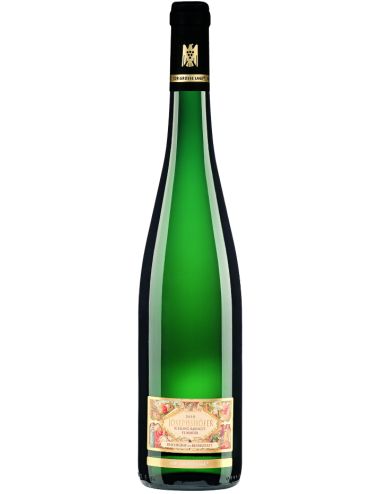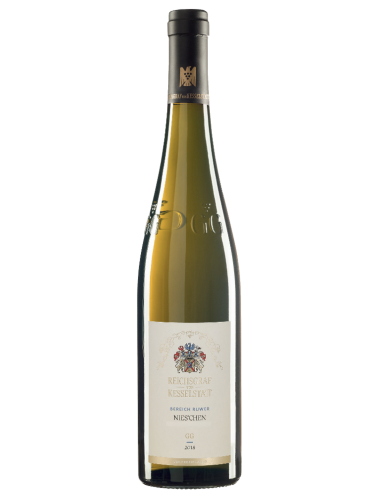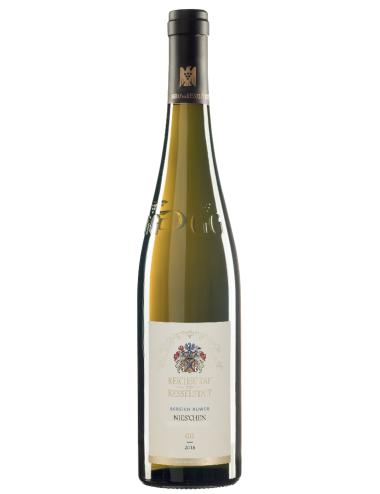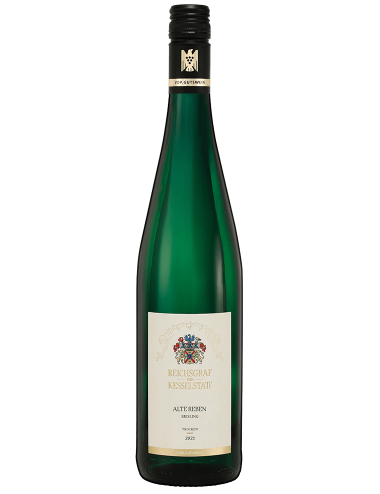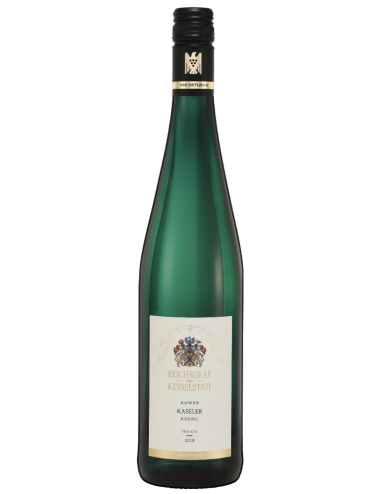
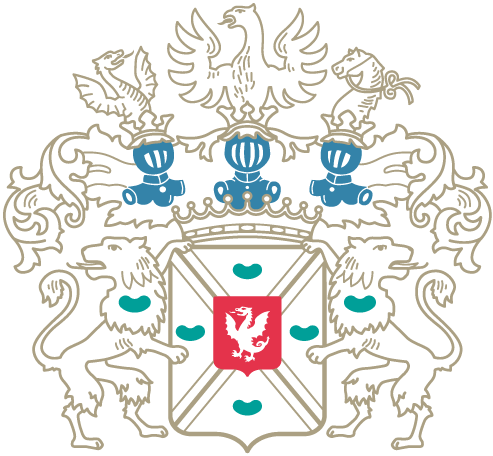
Wine estate Reichsgraf von Kesselstatt
The winery Reichsgraf von Kesselstatt is also one of the most traditional wineries in the Mosel wine region. The winery has been renowned for the highest quality of wine since 1349 and has been dedicated primarily to Riesling since the end of the 18th century. Annegret Reh-Gartner took over the business from her father in 1983.
-
-
Reichsgraf von Kesselstatt
Brauneberger Juffer Sonnenuhr Riesling Spätlese sweet 2020
 Riesling
Riesling
 Fruity
€ 21.40
Fruity
€ 21.40 -
Reichsgraf von Kesselstatt
Brauneberger Juffer Sonnenuhr Riesling Spätlese sweet 2022
 Riesling
Riesling
 Fruity
€ 24.00
Fruity
€ 24.00 -
-
-
Reichsgraf von Kesselstatt
Josephshöfer Riesling Spätlese (late harvest) sweet 2020
 Riesling
Riesling
 Fruity
€ 23.20
Fruity
€ 23.20 -
Reichsgraf von Kesselstatt
Josephshöfer Riesling Spätlese (late harvest) sweet 2022
 Riesling
Riesling
 Fruity
€ 25.00
Fruity
€ 25.00 -
Reichsgraf von Kesselstatt
Scharzhofberger Grosses Gewächs (Grand Cru) Riesling dry 2022
 Riesling
Riesling
 Dry
€ 33.50
Dry
€ 33.50 -
Reichsgraf von Kesselstatt
Scharzhofberger Grosses Gewächs (Grand Cru) Riesling dry 2019
 Riesling
Riesling
 Dry
€ 33.10
Dry
€ 33.10 -
Reichsgraf von Kesselstatt
Josephshöfer Grosses Gewächs (Grand Cru) Riesling dry 2019
 Riesling
Riesling
 Dry
€ 33.10
Dry
€ 33.10 -
Reichsgraf von Kesselstatt
Josephshöfer Grosses Gewächs (Grand Cru) Riesling dry 2021
 Riesling
Riesling
 Dry
€ 33.10
Dry
€ 33.10 -
Reichsgraf von Kesselstatt
Josephshöfer Grosses Gewächs (Grand Cru) Riesling dry 2022
 Riesling
Riesling
 Dry
€ 33.50
Dry
€ 33.50 -
-
-
Reichsgraf von Kesselstatt
Kaseler Nies'chen Grosses Gewächs (Grand Cru) Riesling dry 2019
 Riesling
Riesling
 Dry
€ 33.10
Dry
€ 33.10 -
Reichsgraf von Kesselstatt
Kaseler Nies'chen Grosses Gewächs (Grand Cru) Riesling dry 2020
 Riesling
Riesling
 Dry
€ 33.10
Dry
€ 33.10 -
Reichsgraf von Kesselstatt
Schloss Marienlay Alte Reben (old-vines) Riesling dry 2022
 Riesling
Riesling
 Dry
€ 18.00
Dry
€ 18.00 -
-
Reichsgraf von Kesselstatt
Brauneberger Juffer Sonnenuhr Riesling Spätlese sweet 2018
 Riesling
Riesling
 Fruity
€ 20.90
Fruity
€ 20.90 -
Reichsgraf von Kesselstatt
Josephshöfer Grosses Gewächs (Grand Cru) Riesling dry 2020
 Riesling
Riesling
 Dry
€ 33.10
Dry
€ 33.10 -
-
-
-
-
Reichsgraf von Kesselstatt
Schloss Marienlay Weissburgunder dry (Pinot Blanc) 2023
 Riesling
Riesling
 Off-dry
€ 11.50
Off-dry
€ 11.50
No Product found in this category
No Product found in this category
No Product found in this category
-
Reichsgraf von Kesselstatt
Schloss Marienlay Spätburgunder Rosé (Pinot Noir) dry 2023
 Riesling
Riesling
 Off-dry
€ 9.83
Off-dry
€ 9.83
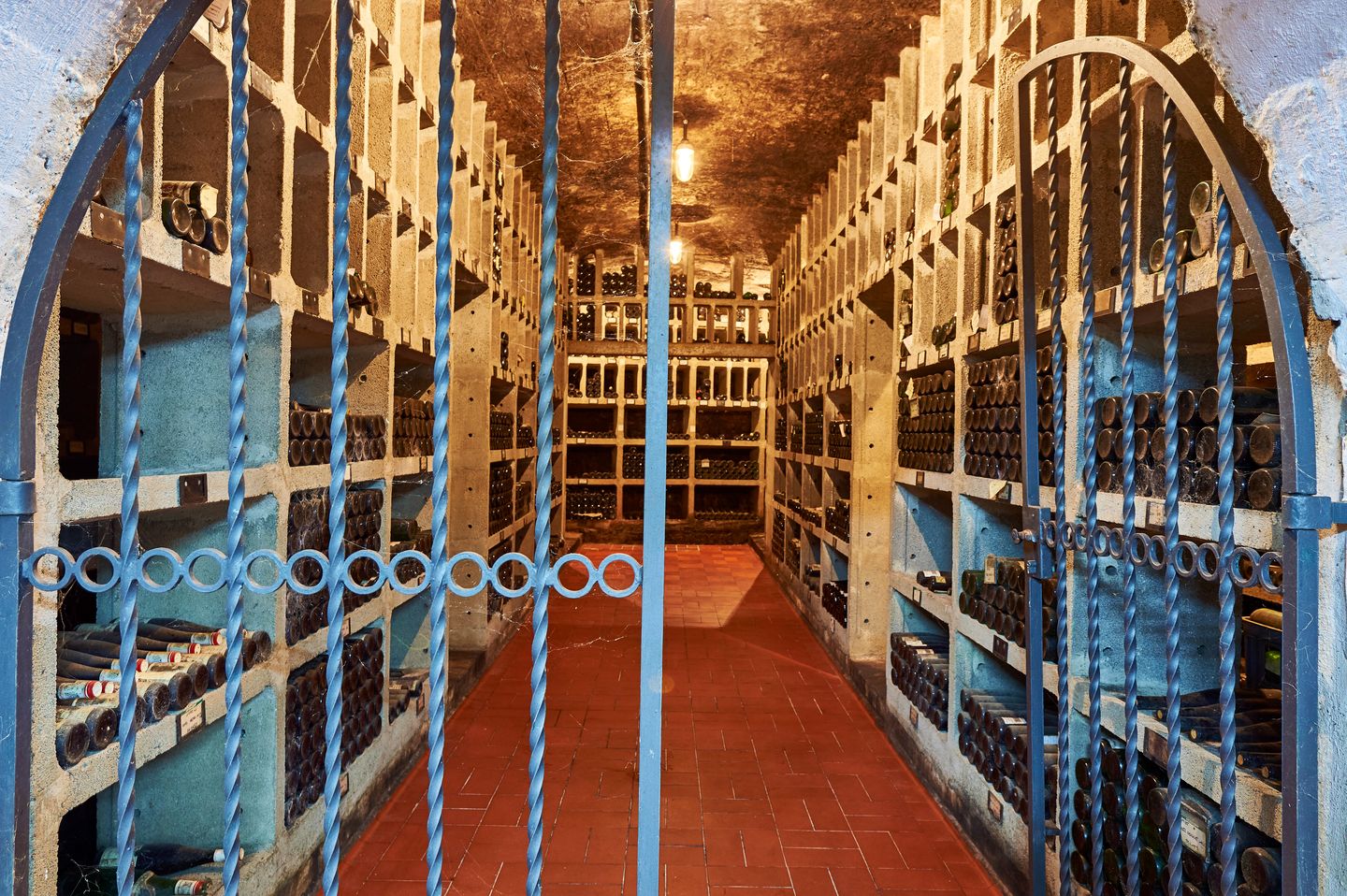
Wine growing tradition since more than 600 years
With its proud age of over 665 years, Reichsgraf von Kesselstatt is considered one of the oldest wineries in the Moselle winegrowing region. Even today, four former Maximiner monasteries - with vineyard holdings and absolute top sites on the Moselle, Saar and Ruwer - form the foundation of the winery. These include the Josephshof in Graach as well as the Domklausenhof in Piesport on the Moselle, the Abteihof in Oberemmel on the Saar and the St. Irminenhof in Kasel on the Ruwer.
Read More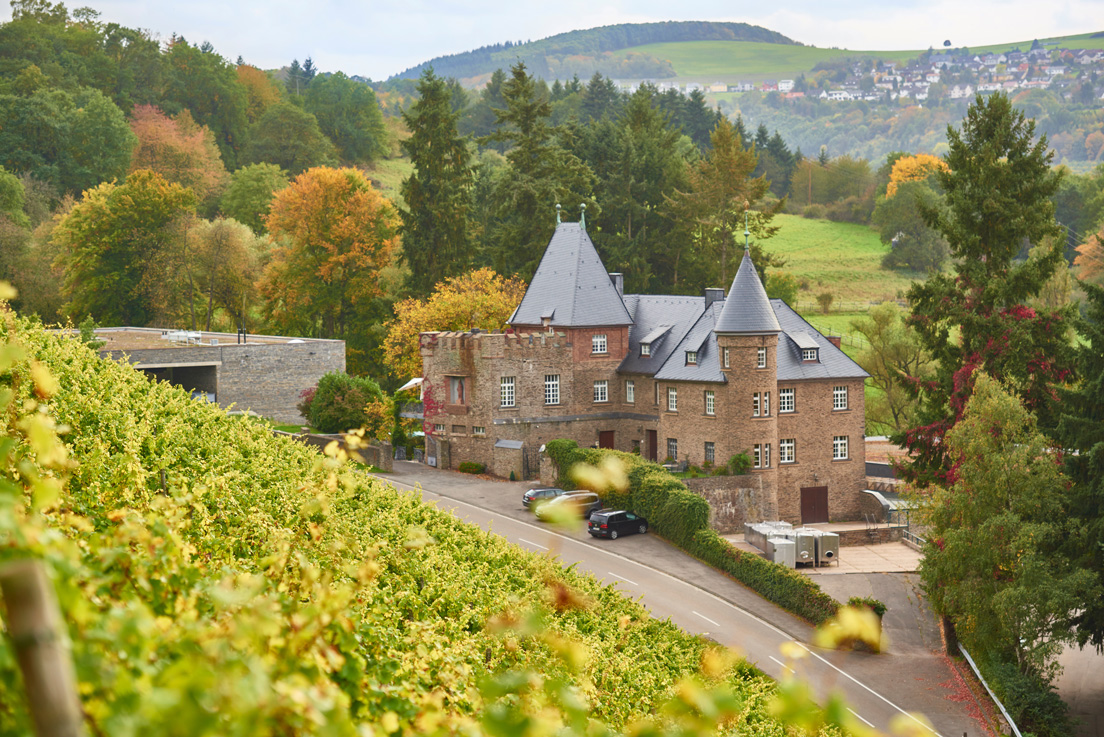
Superb Riesling wines from premium vineyards
The Reichsgraf von Kesselstatt winery is also one of the most traditional wineries in the Mosel wine region. Since 1349, it has been synonymous with great wine enjoyment, and since the end of the 18th century, it has concentrated on Riesling. Annegret Reh-Gartner took over the estate from her father in 1983. Thanks to her constant pursuit of quality, which led to a reduction in the size of the farm, good customer contacts and the enjoyment of wine, she has helped the Reichsgraf von Kesselstatt winery to gain national and international recognition. In addition to three Gault Millau awards, the member of the German Winegrowers' Association (VDP) can look forward to many other awards. Annegret Reh-Gartner managed the estate for 33 years (until 2016) with great passion, entrepreneurial foresight and commitment. In July 2020, Dr. Karsten Weyand took over the management of the domain.
Sustainable winemaking results in extraordinary wines from steep slopes
Today, the management is in the hands of Dr. Karsten Weyand. He runs the winery with its own bottling at the castle, in collaboration with the Kesselstatt team. In total, the estate has 46 hectares on the Moselle, Saar and Ruwer rivers, with an exceptional range of top sites in the three river valleys of the wine region. This unique potential of terroirs and the constant demand for high quality wines have made the estate internationally renowned. A lot of love and passion is invested in the production and maturation of dry, long-keeping wines, whose unmistakable, mineral and delicate style, typical of the Moselle, Saar and Ruwer regions, is and remains essential and with which no other wine region can compete. The Kesselstatt team relies on natural fermentation in stainless steel tanks (spontaneous fermentation), as well as on traditional wooden barrels for the grand cru wines. A region with potential for great dry wines that do not shine by their alcohol, but by their elegance and minerality.
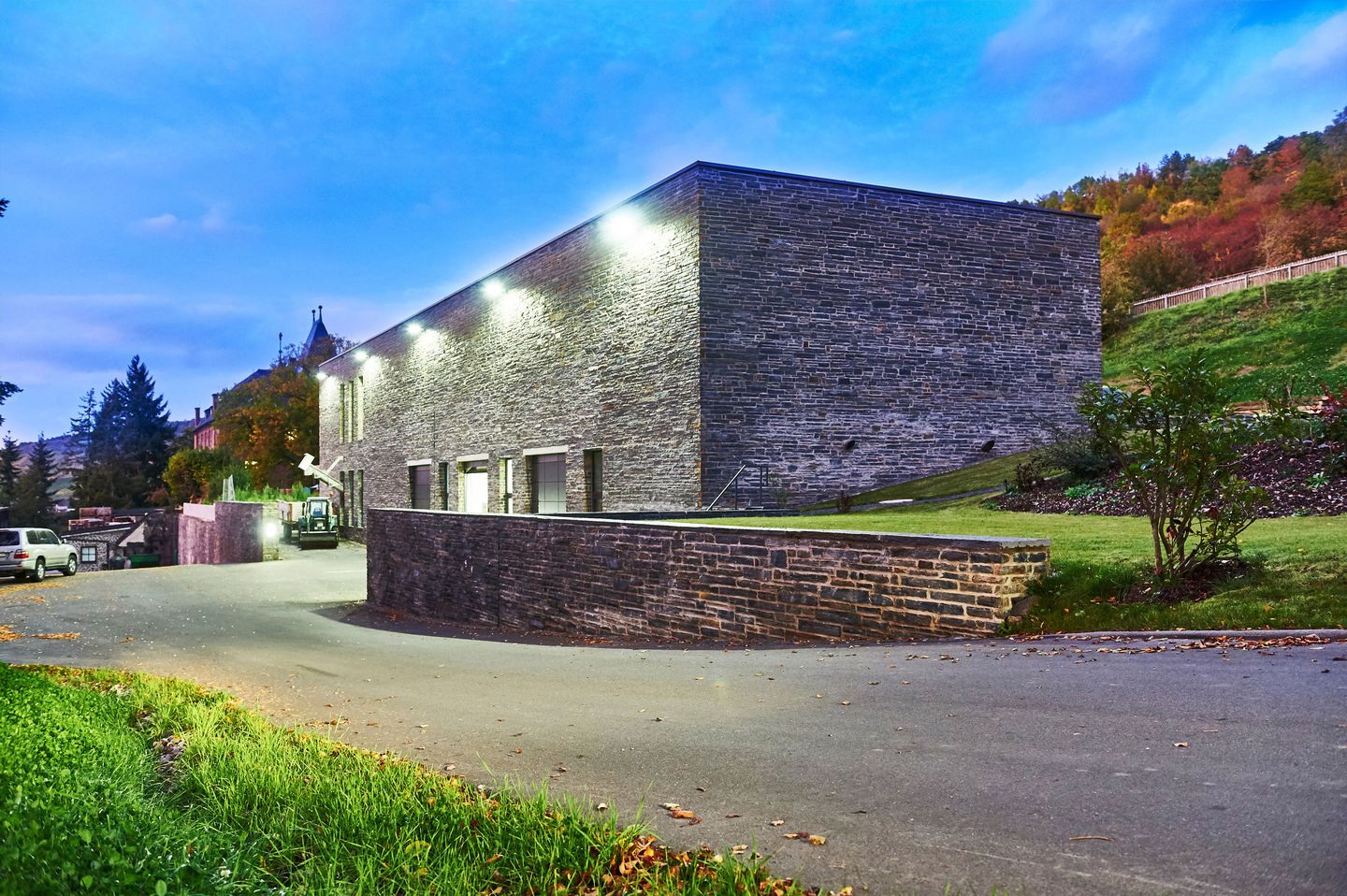
The vineyards of Reichsgraf von Kesselstatt
Josephshöfer
is a monopoly Vineyard of the Reichsgraf von Kesselstatt winery and is located in Graach on the Moselle in the district of Bernkastel-Wittlich It is part of the Münzlay large-scale vineyard. The site has a total area of 5 ha and is solely owned by the winery. It lies 119 to 165 m above sea level and has a south-south-west orientation, as well as a slope of 44 - 53%. Soil conditions: Deep, gray Devonian slate weathered soil with a high percentage of fine soil (a relatively heavy soil by Moselle standards).
The results of this monopoly site are full-bodied, spicy wines with lots of charm and incredible aging potential. Characteristically, the unmistakable aroma of orange blossom and tangerine peel with a hint of wild herbs and earthy spicy components can often be found.
Graacher Domprobst
The Graacher Domprobst is a Grosse Lage and rightly so. The top vineyard site Graacher Domprobst is one of the best that the Middle Mosel has to offer in terms of vineyards. Directly adjacent to the monopollage Josephshöfer and framed by the Graacher Himmelreich, the Domprobst is the centerpiece of the Graacher sites. At 130 to 260 meters above sea level, the Riesling vines grow here, some of which are rootless.
The site is predestined for viticulture. Protected from wind and frost, the grapes continue to benefit from the easily warmed slate soils. Below the meter-thick layer of clay slate weathering is a clay terrace, which has a positive effect on the water supply of the vines during dry phases.
Once upon a time, ⅓ of Graach's wine tithe was due to the Trier cathedral provost. This is how the vineyard site got its name. Wines that originate here often show themselves to be exceptionally spicy and aromatic with an imposing minerality and finesse. Above all, the sophisticated Riesling brings out qualities that are truly exceptional.Even before 1800 was known what top wines this site produces. The Graacher Domprobst has a slope of up to 70% with optimal south-west orientation. The topography protects the vineyards from wind and frost and allows a very long ripening period. The deep slate soil, dominated by clay minerals, together with the microclimatic conditions, allows the emergence of the finest fruit aromas and minerality.
Wehlener Sonnenuhr
The Wehlener Sonnenuhr vineyard is also known for the fact that the entire vineyard is sloping. The vineyards face south/southwest and are located at an altitude of 110 to 250 meters.
Initially, the Wehlener Sonnenuhr vineyard covered 8 hectares, which have now grown to over 45 hectares due to their exceptional quality. Only Riesling is grown on a stony, gray Devonian soil with weathered slate. The slate thus stores the heat of the day and releases it to the vines at night. The vineyards located directly on the Moselle benefit particularly from the heat reflection.
The clayey soils of Devonian slate provide the juiciness and minerality of the wines. Their racy acidity supports the wines in terms of their storage potential. Wehlener Sonnenuhr wines are happy to be forgotten in a cellar at the right temperature for a few years, after which they can be enjoyed to the full.
Furthermore, the soil type of the Wehlener Sonnenuhr offers ideal conditions for varietal wines, late harvests and sweet wines. But even when vinified dry, the Rieslings of the Wehlener Sonnenuhr can produce wonderful Grosse Gewächse from VDP vintners. The wines of the Wehlener Sonnenuhr are elegant Rieslings with a delicate fragrance and fresh acidity. The Riesling has the aromas of peach and green apple typical of the vineyard.
Piesporter Goldtröpfchen
Piesport is one of the oldest wine-producing villages in the Moselle. The Romans already cultivated vines here. This is proven by a wine press (the largest north of the Alps) discovered in 1985 in the middle of the golden drop of Piesport. The Goldtröpfchen vineyard in Piesport is located on the U-shaped arc of the Moselle and resembles an open amphitheater.
The 66-hectare vineyard stretches from the Ferres district in Piesport to the Moselloreley on a south-easterly exposure. The orientation of the vineyards ensures sufficient sunshine from summer to late autumn to allow the growth of aromatic grapes. The afforestation upstream of the site ensures good water management, so that the vines are sufficiently supplied with water even in times of drought.
The soil of the Piesporter Goldtröpfchen is composed of blue-gray Devonian schist and a sometimes very high proportion of fine soil. The Rieslings from this soil are very mineral and develop perfectly over the years. The VDP.GROSSE LAGE® GOLDTRÖPFCHEN is situated like a huge amphitheater in the outer loop of the Mosel, which surrounds Piesport here. Its orientation is from south-east to south-west through south. The sunshine duration in the vineyards is long, the east and west slopes protect the opposite sides from the wind. With a slope of 30 to 70 percent, the vineyards are sometimes extremely steep - they rise from 120 to 200 meters in altitude. The soils are dark, deep, heavily weathered Devonian shale, which is impregnated with quartz and minerals and heats up easily. In some places, there is a high proportion of fine soil. Overall, the site has a good water supply for the vines.
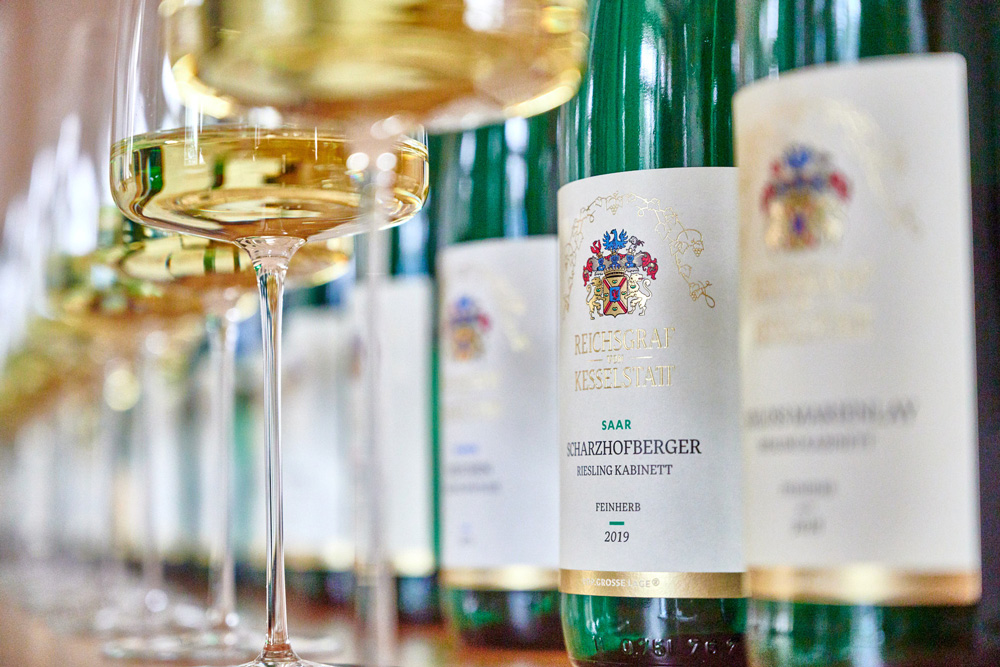
Wine assortment
Riesling
- dry
- Selection (Auslese)
- Late harvest (Spätlese)
- Grand Cru (Grosses Gewächs)
- Sparkling wine
Pinot Noir red wine
Pinot Blanc
Pinor Gris
Winemaking philosophy and quality management
Fermented spontaneously, the wines of Kesselstatt have a stubborn nature that is worth discovering. Quality is a priority. That's why careful manual harvesting and careful selection on the sloping vineyards are part of the daily wine routine, as is the care of particularly old and valuable Riesling vines. Quality can be further improved by viticultural measures such as bunch splitting and green harvesting to reduce yields, as well as leaf removal from the bunch area in early September to reduce botrytis attack. In addition, care is taken to preserve the natural environment of the vines. In order to guarantee perfect quality management in the vineyard and thus enable the production of an exceptional wine, the winemaking team at Reichsgraf von Kesselstatt carries out a strict classification of the terroirs, in accordance with its membership in the Association of Classified German Wine Estates (VDP). Thus, the Riesling impresses with its excellent quality, its elegant minerality and its incomparable lightness.

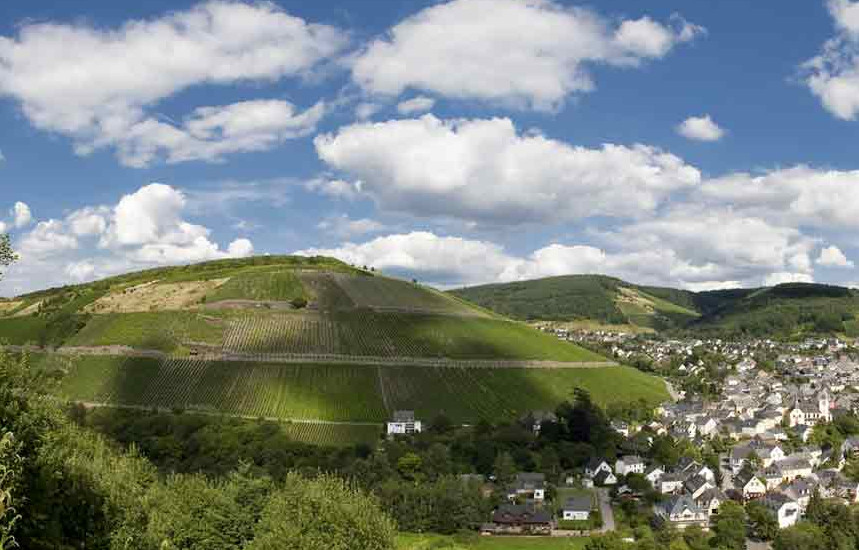
Expressive wines with terroir characteristics
A lot of manual work is required in the steep slopes of the Reichsgraf von Kesselstatt winery. Soils and vines must be cared for in the best possible way, taking into account the weather conditions. Yield-reducing methods such as grape splitting and green harvesting increase the quality of the remaining grapes, while foliage work ensures good yields. At harvest, the grapes are once again rigorously selected so that only the best grapes become wine. Fermentation is as spontaneous as possible and usually in stainless steel tanks, so that the special characteristics of the terroir are preserved. The Grosses Gewächse of the Reichsgraf von Kesselstatt winery are predominantly aged in wooden barrels. Due to the long fine yeast storage, the wines gain in complexity.
The Reichsgraf von Kesselstatt winery cultivates a total of 46 hectares on the Moselle, Saar and Ruwer rivers, including numerous top sites. The soils are characterized by slate and give the Rieslings a pleasant minerality. Juicy, with fine fruit aromas, the entry-level cuvées offer uncomplicated enjoyment. The VDP Domain wines follow in the quality pyramid with a concentrated and racy Riesling from old vines. The VDP.Ortswein Riesling from Kasel impresses with its aromas of exotic fruits and its enormously long finish. For a special treat, the connoisseur reaches for the VDP.Großes Gewächs from the Reichsgraf von Kesselstatt winery and lets the minerality of the filigree Riesling "Piesporter Goldtröpfchen" dance on the tongue.
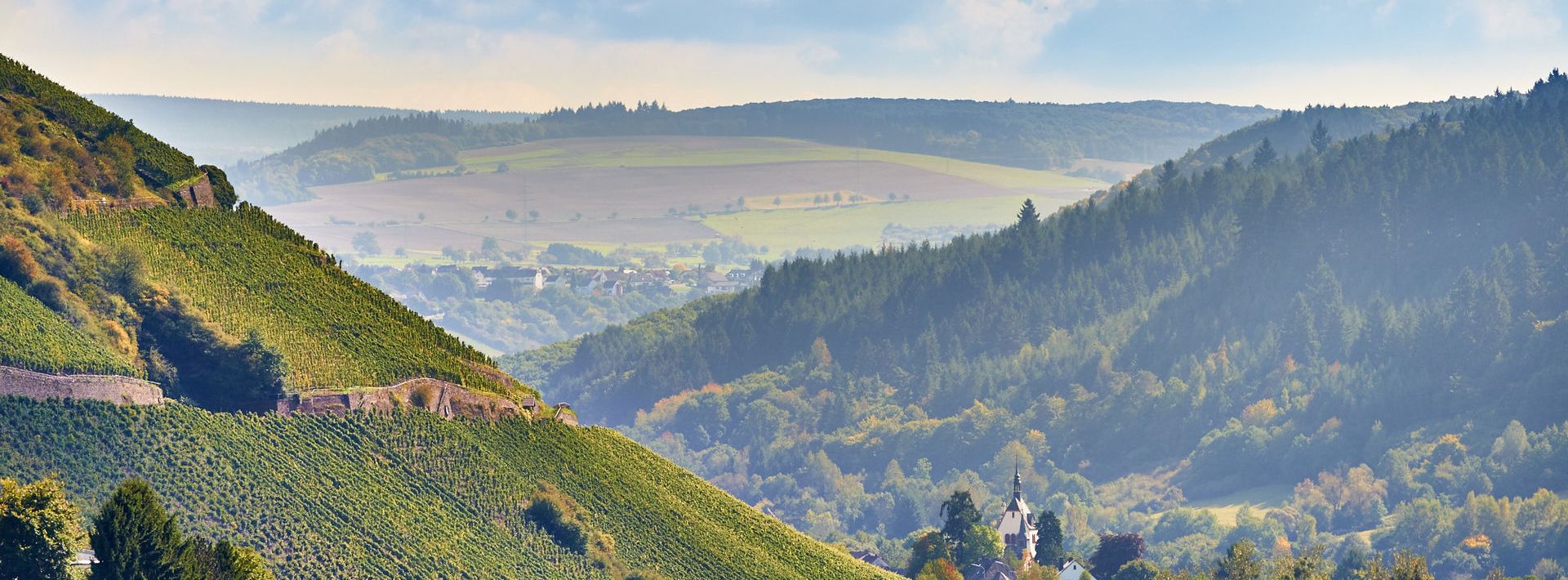
Awards from the press

Falstaff 2022 - 3 Stars
Falstaff 3 Sterne - Winery known for contineous outstanding quality
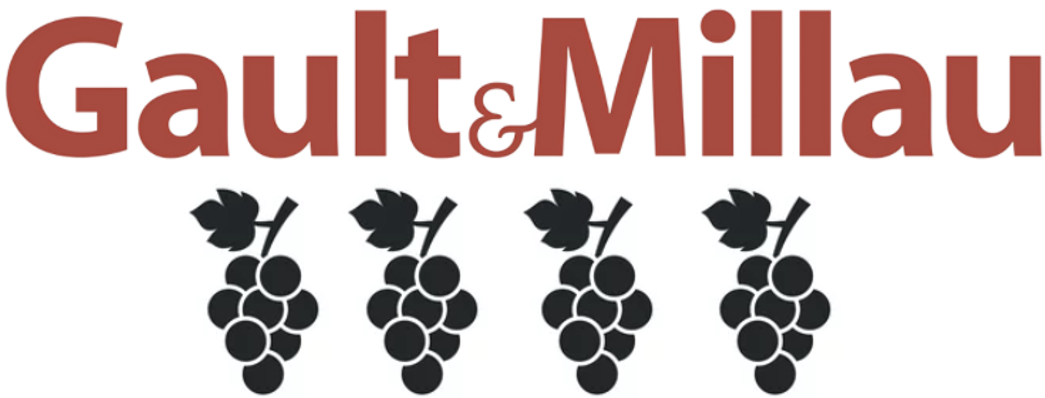
Gault & Milllau - 4 Grapes -Germany Top Ranking
The traditional winery in Schloss Marienlay has been one of the region's flagships for decades. Only a few wineries in the Moselle growing region have such a wide range of potential sites, including the unique monopollage Josephshöfer near Graach. The extensive property also includes parcels in the legendary Scharzhofberg, whose distinctive Rieslings are world-famous.












